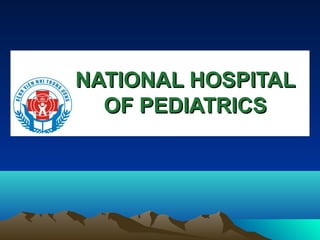
Case report demo 1
- 1. NATIONAL HOSPITALNATIONAL HOSPITAL OF PEDIATRICSOF PEDIATRICS
- 2. AN ATYPICAL RATHKES CLEFT CYSTAN ATYPICAL RATHKES CLEFT CYST ANDAND DIFFERENTIAL DIAGNOSISDIFFERENTIAL DIAGNOSIS Reporter: DR. Hong Nhung Le Imaging Diagnostic Department NATIONAL HOSPITAL OF PEADIATRICS
- 3. INDIVIDUAL INFORMATIONINDIVIDUAL INFORMATION • Name: HOAI LINH PHAM • Sex: Female • Date of birth: November, 9th, 2000 • Address: 516 Alley, Tran Tat Van street, Kien An district, Hai Phong city • Telephone number:01696309762 • Date of examination: June, 21st, 2012- NHP
- 4. CLINICAL MANIFESTATIONCLINICAL MANIFESTATION • Transient headache last for 3 months in recent year • At the time of examination : headache attacks 3 times a week in average • No visual disturbance, no hemianopsia. • Individual history: normal development • Family history: no special finding.
- 5. SUBCLINICAL TESTSUBCLINICAL TEST • Bone Age: approximately 10 years • Endocrinological Test: Normal pituitary funtion GH= 1.8 µg/l (BT <5.0 µg/l) Prolactin 7.3 µg/l (BT <15.0 µg/l) Thyrotropin 1.0 mU/l (BT 0.1–4.0 mU/l) Luteinizing hormone 21.30 IU/l (BT 15–67 IU/l); Follicle-stimulating hormone 15.50 IU/l (BT 20–40 IU/l); Adrenocorticotropic hormone 16.3 pg/ml (BT 4.4–48.0 pg/ml) Cortisol 10.8 nmol/L (BT 3.2–13.9 nmol/L)
- 6. MRI FindingsMRI Findings (T2W, Axial)(T2W, Axial) Cystic mass: D=15mm
- 7. MRI FindingsMRI Findings (T1W, sagital)(T1W, sagital) Cystic mass in the Sellar and supprasellar extension
- 8. MRI FindingsMRI Findings ((FLAIR coronal)FLAIR coronal) Hypersign compared to CSF mass
- 9. MRI FindingsMRI Findings (T1W Axial-Postcontrast)(T1W Axial-Postcontrast)
- 10. MRI FindingsMRI Findings (T1W Axial-Postcontrast)(T1W Axial-Postcontrast)
- 11. MRI FindingsMRI Findings (T1W Axial-Postcontrast)(T1W Axial-Postcontrast)
- 12. MRI RESULTMRI RESULT Cystic mass in the sella and suprasellar extension: AN ATYPICAL RATHKES CLEFT CYST?
- 13. DIFFERENTIAL DIAGNOSISDIFFERENTIAL DIAGNOSIS • Rathkes cleft cyst • Epidermoid cyst • Craniopharygioma (CR)
- 14. RATHKES CLEFT CYST EPIDERMOID CYST CRANIOPHARY- GIOMA DEMOGRAPHICS At any age Gender: F>M At any age Adamatinomatous: 5-15 year Papilary: above 50 year Gender: M=F FEATURE - 40% infrasella, 60% suprasellar extension - Size: 5-15mm - Suprasellar - Varying size - 75% suprasella; 21% combination; 4% infrasella - Size >5cm CLINICAL SIGNS • Asymtomatic • Symtomatic: - Pituitary disfuntion - Headache - Visual disturbance - Visual disturbance - Headache - Visual disturbance - Pituitary disfuntion DIFFERENTIAL DIAGNOSIS
- 15. RATHKES CLEFT CYST EPIDERMOID CYST CRANIOPHARY -GIOMA MRI - Varying signal. - Intracystic nodule : 70%. - FLAIR:hypersign - No internal enhance; +/- rim of compressed pituitary - Varying signal - TIWI: hypersignal - No enhance or minimal rim enhance, - Restriction on DWI - 90%Calcified, solid, cyst - FLAIR=hyper - 90% Enhance =rim(capsule) +nodule(solid) CT-SCANNER - 75% hypointense, - Nonenhanced From -100 to +30 HU Adamatinomatous: 90% calci DIAGNOSTIC CHECKLIST Intracystic nodule FAT on CT Strong enhancement DIFFERENTIAL DIAGNOSIS
- 16. RATHKES CLEFT CYST EPIDERMOID CYST CRANIOPHARY- GIOMA PROGNOSIS - Most stable. - May shrink and disappear. - Noneoplasm - Most stable - Noneoplasm - Slow growing benign neoplasm - Survival>10Y:60% TREATMENT - Conservative - Aspiration/excision if Symtomatic - Primary sugery - Surgery and radiation RECURRENCE - Rate<1/3 - Rate<1/3 - Size > 5 cm: ~80% - Size <5 cm: ~20% DIFFERENTIAL DIAGNOSIS
- 17. TYPICAL RATHKES CLEFT CYSTTYPICAL RATHKES CLEFT CYST Intracystic nodule
- 18. INTRACYSTIC NODULEINTRACYSTIC NODULE (Continuing)(Continuing) Hypersignal on T1W Hyposignal on T2W
- 19. ATYPICAL RATHKES CLEFT CYSTATYPICAL RATHKES CLEFT CYST
- 20. TYPICAL EPIDERMOID CYSTTYPICAL EPIDERMOID CYST T1 W coronal Precontrast:T1 W coronal Precontrast: Cystic mass in the suprasella
- 21. TYPICAL EPIDERMOID CYSTTYPICAL EPIDERMOID CYST T1 W coronal PostcontrastT1 W coronal Postcontrast Rim enhanced mass
- 23. TYPICAL CRANIOPHARYGIOMATYPICAL CRANIOPHARYGIOMA Strong enhancement at capsule and solid structure
- 24. DISCUSSIONDISCUSSION • Imaging technique on MRI. • Embryology of Rathkes pouch and Rathkes cleft cyst. • Diagnostic checklist. • Treatment strategy
- 25. IMAGING TECHNIQUEIMAGING TECHNIQUE • High resolution:2-3mm (thick) • Sagital T1 pre+postcontrast • Coronal T1 pre+postcontrast • Axial T2W • Dynamic gadolium enhance coronal T1 for microadenoma (20s subsequence)
- 26. EMBRYOLOGYEMBRYOLOGY A: Infundibulum and Rathke's pouch develop from neural ectoderm and oral ectoderm, respectively. B: Rathke's pouch constricts at base. C: Rathke's pouch completely separates from oral epithelium. D: Adenohypophysis is formed by development of pars distalis, pars tuberalis, and pars intermedia; neurohypophysis is formed by development of pars nervosa, infundibular stem (median eminence)
- 27. DIAGNOSTIC CHECKLISTDIAGNOSTIC CHECKLIST • On MR images, Rathke's cleft cysts (RCC) show various signal intensities. • The key figure considered to be indicative of RCC is intracystic nodule. • Finding intracystic nodule difficult and overlook when similar to signal of cystic surrounding.
- 28. TREATMENT STRATEGYTREATMENT STRATEGY • Symtomatic Rathkes cleft cyst (RC)and Epidermoid cyst (EC) have the same treatment strategy. • Symptomatic RCC or EC should be treated carefully with simple evacuation, irrigation, and biopsy via a transsphenoidal route. • Craniopharygioma require a different treatment strategy, including the choice of meticulous dissection from the hypothalamus or radiation or both.
- 29. CONCLUSIONCONCLUSION • Our case demonstrates any potential lesion may occur. We should take the follow-up examination regularly by MRI to evaluate the lesion’s progress (6),(10) • If the headache or any other symtom involving the cyst development, decision for extensive surgery must be made on the basis of histopathologic analysis. (11)
- 30. REFERENCEREFERENCE 4. Voelker JL, Campbell RL, Muller J. Clinical, radiographic, and pathological features of symptomatic Rathke's cleft cysts. J Neurosurg 1991;74:535-544 5. Keyaki A, Hirano A, Llena JF. Asymptomatic and symptomatic Rathke's cleft cysts. Histological study of 45 cases. Neurol Med Chir (Tokyo)1989;29:88-93 6. El-Mahdy W, Powell M. Transsphenoidal management of 28 symptomatic Rathke's cleft cysts, with special reference to visual and hormonal recovery. Neurosurgery 1998;42:7-17 10. Osborn W Diagnostic Imaging 2000;:875-877; 892-895 11 Woo Mok Byun, Oh Lyong Kim, and Dong sug Kim MR Imaging Findings of Rathke's Cleft Cysts: Significance of Intracystic Nodules AJNR Am J Neuroradiol 2000 21: 485-488
- 31. THANKS FOR YOURTHANKS FOR YOUR ATTENTION!ATTENTION!
Hinweis der Redaktion
- I
- I
- I